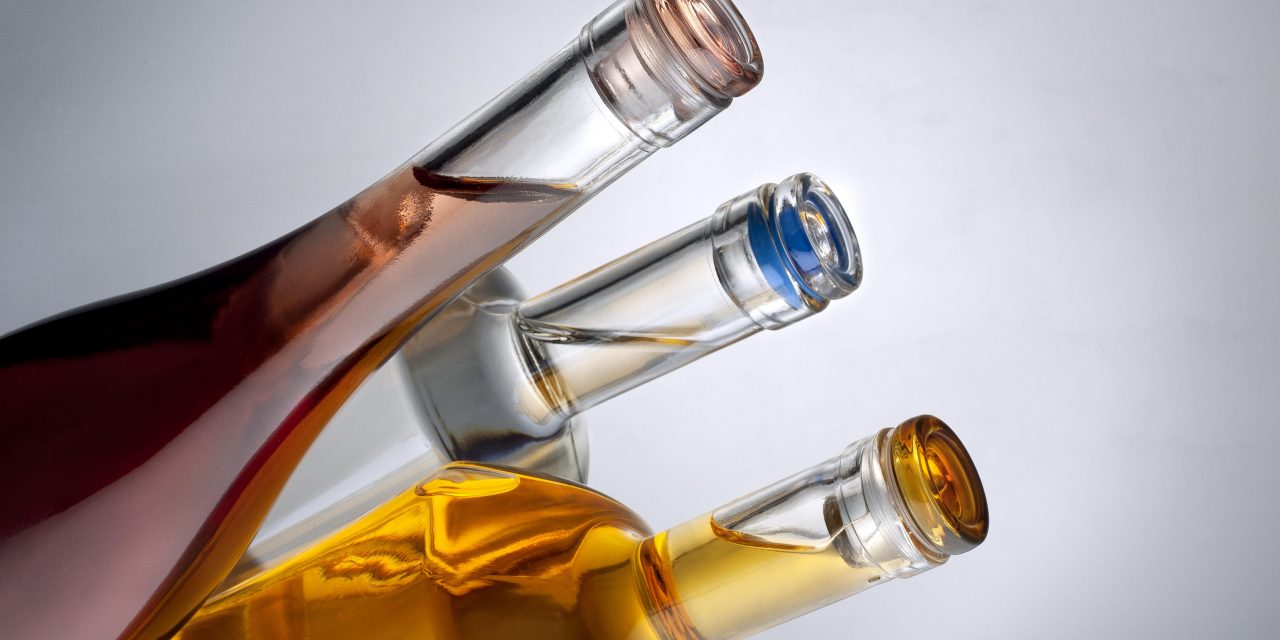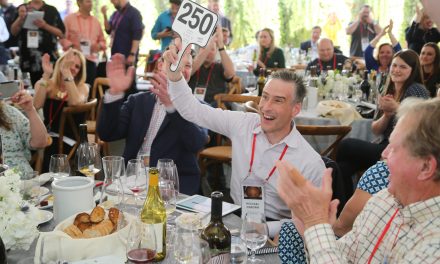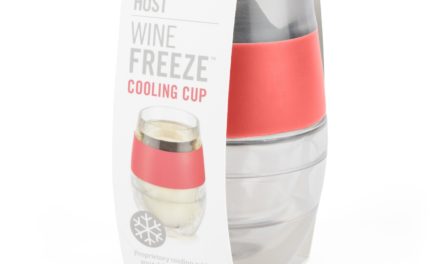In a tradition-bound industry like wine, trendiness probably isn’t the most desirable trait. When it comes to the building blocks of winemaking, producers tend to revere Old-World techniques and styles—methods such as reductive fermentation, gravity-flow racking, and barrel aging—that leave little room for improvement.
Even modern-day bottles adhere to centuries-old standards of shapes, sizes, and colors. “The wine market has historically been very conservative when it comes to packaging,” says Raul Parades, director of design for Owens-Illinois. “But that’s beginning to change. What it wants most is ways to make the familiar look new.
“All beverage producers are looking for ways to convey quality visually, since that’s often the first experience a new consumer has with a brand,” he continues. “Glass is a naturally good choice, because it can be molded and decorated in countless ways to differentiate a brand.”

““Some of the people who’d gone to ultra-light ecobottles started to realize giving up weight also meant giving up quality.” —Michael Riel, MA Silva
If there’s a current trend in wine bottles, according to suppliers, it can be described in one word: premiumization. After nearly a decade battling the effects of the Great Recession, wineries are requesting bottles that radiate quality. And for many winemakers, that means weight.
“Three or four years ago super lightweight bottles were trending,” says M.A. Silva COO Michael Riel. Wineries were seeking an eco-friendly image while at the same time trying to economize on the cost of bottles and shipping.
But today, several suppliers say, wineries are requesting heavier bottles. “Some of the people who’d gone to ultra-light ecobottles started to realize giving up weight also meant giving up quality due to breakage during transport,” explains Riel. “In the end, it looked like they were saving money, but it actually came at a price.”
A Visual Representation of Quality
A bottle that catches the consumer’s eye can be the best way to communicate information that’s difficult to quantify, like a wine’s style or personality. “Many, many wineries can’t afford full-scale advertising campaigns,” says Steve Pelkey, president of Universal Packaging. “For many of them, the most cost-effective way of marketing their brand is through packaging.” And perhaps the strongest message a bottle can send has to do with cold, hard cash—the wine’s price point.
Nothing says “premium,” according to Pelkey, like weight. “There’s still a massive market for low-weight bottles for lower cost wines,” he adds. “But if a winery wants to be seen as a high-priced brand in the marketplace, it has to be in a more robust bottle.”

“We prefer a little more wide-shouldered bottle, a little thicker neck.” —Stephen Cruzan, Titus Vineyards
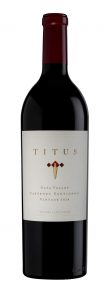 For Stephen Cruzan, winemaker at Titus Vineyards in Napa Valley, the bottle reflects the message he wants to convey about his wines. Titus produces primarily red wines, bottled in classic Bordeaux- or Burgundy-style glass. “We prefer a little more wide-shouldered bottle, a little thicker neck,” Cruzan says. “We like a nice sturdy bottle that looks well-made.”
For Stephen Cruzan, winemaker at Titus Vineyards in Napa Valley, the bottle reflects the message he wants to convey about his wines. Titus produces primarily red wines, bottled in classic Bordeaux- or Burgundy-style glass. “We prefer a little more wide-shouldered bottle, a little thicker neck,” Cruzan says. “We like a nice sturdy bottle that looks well-made.”
Other trends, in particular treatments to the exterior of a bottle, are aimed at creating a distinctive identity, says Thomas Deegan, Ph.D., director of business development for TricorBraun Winepak. His company is seeing more requests for alternative ways to decorate bottles with a winery’s label. In the last year, he adds, he’s seen a trend toward bottles embossed with a cartouche on the neck or shoulder, displaying an identifier like the name of a wine’s appellation of origin. “People are continuing to look for ways to improve their packaging,” he says, especially when the traditional shapes—Claret, Burgundy, and Hock—continue to dominate.
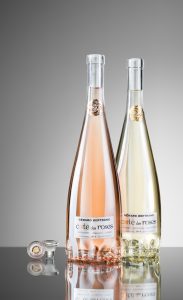 “Since wine has an affinity for familiar shapes, many innovations are coming from other ways to accent the glass,” agrees Parades, who’s responsible for structural design and engineering of all O-I containers developed in the Americas. “Adding texture has become a popular option, and glass offers endless possibilities. People are drawn to things they can touch and interact with in some way.” Options include embossing, debossing, and deep-in-glass applications of texture. “These processes are done to communicate a premium image, and these designs often work in tandem with the wine label—some in fairly traditional ways, and others in a more surprising fashion.”
“Since wine has an affinity for familiar shapes, many innovations are coming from other ways to accent the glass,” agrees Parades, who’s responsible for structural design and engineering of all O-I containers developed in the Americas. “Adding texture has become a popular option, and glass offers endless possibilities. People are drawn to things they can touch and interact with in some way.” Options include embossing, debossing, and deep-in-glass applications of texture. “These processes are done to communicate a premium image, and these designs often work in tandem with the wine label—some in fairly traditional ways, and others in a more surprising fashion.”
Innovations are also evident beyond the bottle surface. “We’re seeing an explosion in the rosé market,” says Isabelle Le Graët, marketing and account manager of SGP Packaging, the U.S. division of Verallia. Some winemakers are innovating with unique designs, such as Gerard Bertrand’s Cotes des Roses bottle, which incorporates a sculptural rose in the base. SGP has also launched an internal engraving process that lets it inscribe designs on the inside of a bottle that don’t become visible until the wine is poured out.
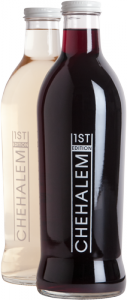
“It’s a fun way to present the freshest possible wine to people who are maybe only used to regular bottles.” —Jon Foster, Chehalem Winery
Growlers Are Growing
Wineries are also innovating as they reach out to more casual consumers. While not yet a large part of the market, growlers are attracting some interest. A familiar concept in the craft beer market, growlers are refillable bottles consumers can buy and bring back to a point of purchase (either a winery or some other outlet licensed to sell the wine) to be refilled.
Jon Foster, a sales manager for Chehalem Winery in Oregon’s Willamette Valley, says growlers might be a bit more environmentally friendly than single-use bottles, but sustainability isn’t their main attraction. “It’s a fun way to present the freshest possible wine to people who are maybe only used to regular bottles,” he says. Wines designated for growler sales at Chehalem are stored in stainless steel kegs. The one-liter growlers are sealed with a screw cap, which is replaced when a customer refills the bottle at the winery. “We provide or refill clean bottles and capsules, and we sparge every growler with inert gas to preserve the freshness of the wine,” Foster says.
In Washington’s Walla Walla Valley, known primarily for high-end, premium wines, Doubleback is also experimenting with a growler-style bottle. Although the winery is not yet allowed to refill them, customers like the bottles, often reusing them at home as water carafes, says Josh McDaniels, winemaker and general manager. “We’re looking at possibly selling kegs, so you can buy a couple of bottles and the keg, and then refill them at your home to reduce glass waste and the inefficiencies of trucking glass weight.”

“Cork taint has always been very frustrating for us. With this bottle, we don’t have that problem.” —Josh McDaniels, Doubleback Winery
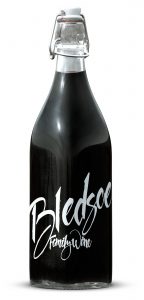 Doubleback uses the growlers for its Bledsoe Family Wine, named for former NFL quarterback Drew Bledsoe, owner of the winery. Bledsoe and his wife, Maura, encountered the refillable concept while traveling in Italy and brought it home to their winery in 2012.
Doubleback uses the growlers for its Bledsoe Family Wine, named for former NFL quarterback Drew Bledsoe, owner of the winery. Bledsoe and his wife, Maura, encountered the refillable concept while traveling in Italy and brought it home to their winery in 2012.
The distinctive, one-liter square bottle is supplied by Bruni Glass, the Italian bottle supplier renowned for its biennial design competition. The company gathers design students from across Europe for an intense internship, educating them in all aspects of glass production. The students then each design a bottle in one of four different categories—spirits, wine, olive oil, or food. Bruni clients vote on the designs, and the winning bottles become part of the company’s product line.
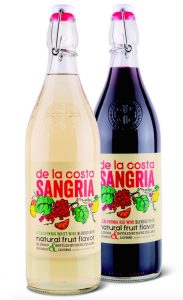
Flip-top bottles are one packaging innovation that’s being embraced in the wine industry. Providers like TricorBraun (De la Costa sangria) and Bruni Glass (Bledsoe Family Wine) are helping popularize this bottle style, which conveys a more casual, playful image.
Some elegant variations on classic wine bottles have been born from the competition, but for truly eye-catching and innovative design, look to distilleries and spirits vying for attention on a bartender’s back bar. In the wine world, as Deegan points out, time-tested traditions still reign. The colors and shapes of wine bottles have been developed over centuries, often as a means of protecting or even improving the contents. “Wine is a developing product,” Deegan says. “It continues to develop for years after you put it in the bottle.” Because of this, he says, “When it comes to bottles, people don’t get too far outside the traditional.”
Closure Concerns
If change comes slowly to the wine bottle market, things move a little more quickly in the world of closures. The closure a winemaker chooses is the finishing piece in a long process. And while it’s the smallest piece of the cost in delivering a bottle to the consumer, it’s at the top of the list in importance. Whether natural cork, synthetic cork, screw cap, or something more unique, a bottle’s closure is the final barrier between the wine inside and the big, bad world outside. Most winemakers choose carefully, and today they have more options than ever.

M.A. Silva has developed technology that detects TCA by examining the molecules surrounding a cork.
One of the biggest concerns with any closure is the risk of TCA, the chemical contaminant sometimes present in natural cork that can have devastating negative effects on a wine’s flavor (cork taint is also a source of frustration in beer, spirits, and ciders bottled with cork closures). M.A. Silva last year introduced a technology that detects TCA by examining the molecules surrounding a cork without having to destroy or damage the cork itself, says Riel. Individual TCA testing is available from many cork suppliers, but Riel says his company’s process is the most reliable yet: “We spent three years and €2.5 million developing it. It’s the most robust and efficient test on the market.” The company claims a success rate in eliminating TCA as high as 100 percent. “We’re aiming for 100 percent, and I’m very confident that it’s working,” Riel says. The process adds 15 cents to the price of each cork sold in the United States and is currently only available for its very high-end corks.
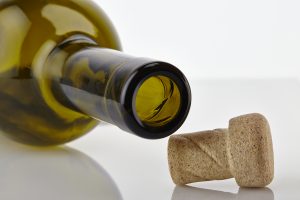
Owens-Illinois’s Helix closure combines the convenience of a screw cap with the aesthetic of cork.
More Closure Options
Besides protecting the wine, a bottle closure, whether cork or synthetic, also must let the wine age properly. A number of producers are offering viable alternatives.
“There’s been a steady move away from cork and artificial cork, toward the ROPP screw cap as convenience has become more important,” says O-I’s Parades. “It’s gained greater acceptance at all levels of wine.” Owens-Illinois has partnered with Amorim to create Helix, a bottle-and-closure combination that offers the convenience of a screw cap and the benefits of cork by combining an ergonomically designed cork and a glass bottle with an internal thread in the neck. This lets users remove the cork simply by holding and twisting the top. After opening, the stopper can also be re-inserted in the bottle in the same way. “It’s a unique consumer experience—utilitarian and cool,” he says.

Vinventions CIO Malcolm Thompson says the Nomacorc Green Line Reserva (pictured) is “virtually indistinguishable from high-end natural cork.”
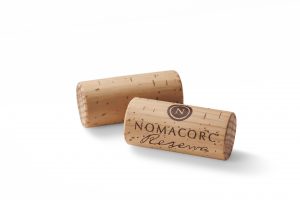 Vinventions has developed its Nomacorc Green Line that offers winemakers precise oxygen management and, at the same time, is “the world’s one and only zero-carbon-footprint closure,” says Chief Innovation Officer Malcolm Thompson. The flagship, Reserva closure provides up to 25 years’ preservation and is “virtually indistinguishable from high-end natural cork. The closures are also completely TCA- and glue-free.”
Vinventions has developed its Nomacorc Green Line that offers winemakers precise oxygen management and, at the same time, is “the world’s one and only zero-carbon-footprint closure,” says Chief Innovation Officer Malcolm Thompson. The flagship, Reserva closure provides up to 25 years’ preservation and is “virtually indistinguishable from high-end natural cork. The closures are also completely TCA- and glue-free.”
Nomacorc PlantCorc closures are made of a bio-based polyethylene derived from sugar cane. As a perennial crop with a high yield per acre, Thompson explains, sugar cane is highly efficient and considered to be a negative-carbon crop. The manufacturing process raises it slightly, but the closures retain that negative carbon footprint rating. “The real difference relates to oxygen management and Nomacorc Green Line closures’ consistent and controllable oxygen transfer rates,” Thompson says. “It lets winemakers choose a closure with a specific OTR based on their wine’s intended shelf life and desired tasting profile.”
That’s a concern to Cruzan, who uses Nomacorc in bottles of Titus’s Sauvignon Blanc. “If a lot of oxygen flows into Sauvignon Blanc, it can get tired fairly fast and lose its charm,” he says. “Nomacorc controls the flow of oxygen into the wine very, very carefully.”
Doubleback Winery uses a flip-top closure on the winery’s Bledsoe Family Wine, which makes up 15 percent of its entire production. “We want to be innovative and try to lead the market in terms of new closures, especially with cork taint the way it is,” says McDaniels. “You work so hard on wine for multiple years and then you inevitably end up getting a corked bottle. It’s really frustrating. With this closure, we don’t have that problem.”
But the flip-top is only one option at Doubleback. McDaniels seals the premium Doubleback wines with natural cork. And for his rosé and Syrah, he’s opted for a glass stopper, one of the hottest trends in wine closures.
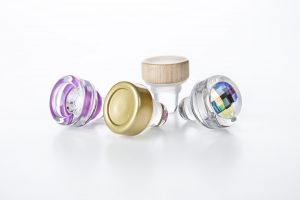 Easier than it sounds
Easier than it sounds
Universal Packaging is the North American distributor for Preciosa, a Czech fabricator of fine glass and crystal that manufactures Vinoseal, a premium glass closure. Available in both a high top and low top, and customizable to match PMS colors, the closure can also be custom-printed to coordinate with a winery’s label. “More packaging and design firms are recognizing the need to stand out,” says Pelkey. “Wineries are trying to distinguish their packaging wherever they can. The Vinoseal closure is unique, and it adds an element of class and premiumization to the package at a small price.”
The biggest advantage to the product, he says, is the glass itself. “It’s better because glass is inert,” he explains, eliminating any possibility of taint. “When you use a glass closure with a glass bottle, nothing can impact the taste of the wine.”
Glass closures are usually applied by hand, making them a more labor-intensive option than cork. But McDaniels says his group overcame that obstacle quickly. “We call it Santa’s workshop,” he laughs. “There are two people wearing rubber gloves on the bottling line inserting the closures in the bottles, and then there are two more with rubber mallets tapping them in.”
The whole process goes much more smoothly than it might sound. “We’ve been using them since 2009,” he says, “and we’ve only had one broken bottle and no issues.”
The biggest labor investment, he adds, comes with the flip-top closures on the Bledsoe Family Wine. With each closure, “the cage is applied by hand, it’s closed by hand, and then we apply a heat seal by hand.” Still, McDaniels says, the effort is worth it.
As with all things packaging, a product’s visual message is often the first point of contact for a consumer. Make yours memorable for all the right reasons.

